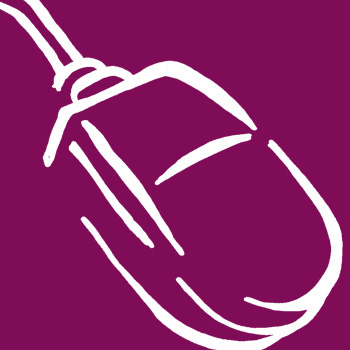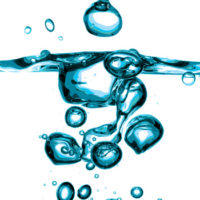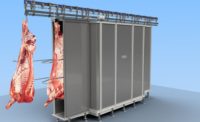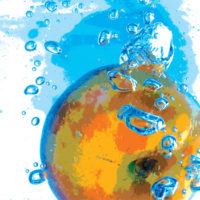Water: Ensuring Its Safety for Use in Food Processing Operations

Water is widely used within the food processing industry. It is sprayed, injected, dripped, poured, ladled and conveyed through food processing establishments around the world. It is used for washing, cutting and for conveying fruits and vegetables. Water is used to lubricate food contact surfaces and other components of processing equipment. It is added to hams, candy and confectionary products. Water is used for glazing fish and other frozen foods. It is used in sausage making and in making salsas and spaghetti sauces. Water is used in retorting and pasteurizing processes as both a heating or cooling medium. It is used equally in its gaseous, solid and liquid states. Water is captured and stored, recycled and reused in a multitude of food processing operations. It is routinely used as a processing aid, as an indirect additive or as a food ingredient. In fact, water is frequently the primary ingredient in a wide variety of processed foods and beverages.
A safe supply of water is as critical to the food industry as it is to sustaining life on this planet. Developing and implementing a water monitoring program, particularly in light of the unique relationship between food processors and their water suppliers and current official information about waterborne contaminants, is an essential part of an effective food safety program.
VENDOR ASSURANCE: DO WE REALLY HAVE IT?
Typically, water that is supplied to food processing establishments is derived either from privately owned wells or publicly owned treatment facilities. Within the food industry it is customary for processors to establish vendor or supplier assurance programs. One of the objectives of these programs is to assure the safety of the ingredients and components used in the food processing operation. The vendor assurance program is an effective method for identifying and managing sensitive ingredients; i.e., those known to contain hazardous substances.
The hallmarks of an effective vendor assurance program are mutually agreed specifications, as well as an understanding by both the supplier and the processor of each other’s capabilities and limitation with respect to the potential hazard. These programs recognize the interdependence of the various elements of the manufacturing supply chain in achieving food safety. Resulting from this relationship may be any number of reports and documents that are intended to demonstrate proof of process; that is, credible evidence that the supplier has maintained a level of control over his manufacturing processes that will ensure the end user of his product an acceptable level of risk. The certificate of analysis (COA) is routinely used for this purpose.
The COA contains information or data obtained from monitoring the various elements of a manufacturing process. These data are intended to indicate conformance with the requirements of the specification. Processors routinely require receipt of a COA in advance of receiving a shipment. Assuredly, the processor would not use the material in his operations until the appropriate company personnel have reviewed and accepted the COA. In the majority of cases, failure by the vendor to achieve the critical requirements for the product or process are grounds for rejecting a shipment and, ultimately, the disqualification of an approved supplier.
In practice, however, these rigorous vendor assurance programs do not exist between food processors and their water suppliers. The prevailing view within the food industry is a belief that drinking water in the U.S. is safe. More simply stated, the public health status of drinking water in the U.S. is taken for granted. This assessment is not necessarily supported by published data. The Centers for Disease Control and Prevention (CDC) data published in its Surveillance for Waterborne-Disease Outbreaks, US., 1997-1998, Morbidity and Mortality Weekly Report, indicates that drinking water may be a significant source for biological and chemical contaminants.
Since 1971, the CDC and the U.S. Environmental Protection Agency (EPA) have maintained a collaborative surveillance system for collecting and periodically reporting data related to occurrences and causes of waterborne disease outbreaks. The surveillance system includes data regarding outbreaks associated with drinking water and recreational water. CDC and EPA surveillance data call into question the quality and safety of potable water. These data indicate that since 1971 more than 30% of U.S. states have reported waterborne disease outbreaks. These agencies also report that for the period 1980 to 1996 there were a total of 401 waterborne disease outbreaks and that these episodes have adversely impacted the lives of millions of Americans. EPA and CDC personnel involved with the report also noted that due to underreporting, their data were not an accurate assessment of waterborne disease outbreaks in the U.S.
Surveillance data for 1997-1998, the most recent data available, indicate that a total of 13 states reported 17 outbreaks associated with drinking water. These outbreaks caused an estimated 2,038 persons to become ill. The microbial or chemical agent that caused the outbreak was identified in more than 70% of the outbreaks. These data also report that nearly 90% of the outbreaks were linked to groundwater sources. The data further show that approximately 60% of the reported outbreaks were of known infectious etiology, while just over 11% of the episodes were attributed to chemical poisoning.
For those outbreaks associated with microbial agents, 60% were caused by parasites. Bacteria accounted for the balance of the outbreaks. The parasites included Giardia and Cryptosporidium. The predominant (75%) bacterial agent was E. coli O157:H7. Shigella sonnei was identified as the causative agent in a single outbreak. E. coli O157:H7 has recently been implicated as the etiological agent in a number of foodborne disease outbreaks. Copper poisoning was responsible for the outbreaks that were attributed to chemical agents. It is also noteworthy that the Surveillance Report concludes that waterborne chemical poisonings are likely underreported to CDC.
While the EPA and CDC data are not complete, they do suggest that food processors are justified either in establishing programs for on-site treatment of their water supply or in developing procedures for monitoring its potability.
STRATEGIES FOR MONITORING
The first steps in setting up a monitoring program require detailed knowledge of the processor’s products and the intended consumers. The processor should also seek to obtain detailed information regarding the origins and mode of distribution of their water supply.
Understanding the product and the intended consumer is fundamental to the development of a coherent water monitoring program. Is the food treated or otherwise processed so as to be lethal to pathogenic organisms? Or is the food a product that is devoid of a kill step and therefore capable of supporting microbial pathogens? Are infants, small children and cancer patients undergoing chemotherapy the intended users of the food? Clearly, the answers to these questions will ultimately dictate the scope and intensity of the monitoring program.
Detailed knowledge about water supply is also critical to understanding the risk that it may represent for your products. Is the water derived from a surface or groundwater source? Is the water from privately own wells or from a public water treatment facility? What type of treatment regimen does the water supplier use? What chemical additives are used in the treatment process? It is also important to know the types of testing performed on the water supply and the availability of the test results.
By way of example, a food processor operating a plant within the metropolitan Seattle, WA, area should know that the water supplied by the public utility is derived from both surface and groundwater (wells) sources, but that the primary supply is from surface water sources. More importantly the processor should know that of the two primary sources, only one is treated with a process that is efficacious in the removal of Cryptosporidium. It is also of value to the processor to know that coagulants, flocculants, corrosion control minerals and fluoride are added to the water and that ozonation and chlorination are used as primary mode of disinfectants. A processor with operations located south of Green Lake would also need to know that water supplied that location might contain Cryptosporidium. The public utility tests the supply at the treatment works in accordance with EPA requirements. Testing includes: microbiological parameters; disinfection by-products; iron; manganese; sulfate; lead; copper; nitrates; and an assortment of other compounds. Testing results are summarized in an annual report. It is also possible to work with the utility to obtain these data more frequently.
In addition to the aforementioned, it is also advisable to seek out information about the distribution system. For example, it is important to have some idea of the system’s age. It is also important to know whether or not wastewater lines are placed in the same subterranean street beds with potable water lines and if the potable water system is adequately pressurized to prevent cross-contamination in the event of a ruptured sewer line. Historically, significant portions of water- borne disease outbreaks reported by CDC are caused by distribution system deficiencies. Between 1971 and 1994, approximately 53 waterborne disease outbreaks reported were associated with distribution system deficiencies.
If the potable water supply is sourced from privately owned wells, a hydrologist should be consulted to assess physical condition of the well and its surrounding environment. The hydrologist might also be asked to provide a view to the likely future performance of the well. The well’s water should also be broadly tested for both chemical and microbial contaminants. A chemical assay should be completed annually and microbiological testing done quarterly.
Product information coupled with information about the water supply will factor heavily in determining what conditions or attributes of the water supply require monitoring. First, before beginning the development of a monitoring program—whether the monitoring is of a privately owned well or of a public water source—it is imperative that the program include both the “supply as it is delivered to the factory” and “as it is contained within the factory’s plumbing.” For effective monitoring, these elements should be viewed as separate and distinct delivery streams. The benefit of this separation is the illumination of the sources of contaminants. In fact, contamination may not always be associated with the water supply as delivered; rather, the contamination may result from cross-connections between potable and nonpotable sources within the factory’s plumbing.
“THE WATER SUPPLY AS DELIVERED”
Many leading food and beverage companies routinely receive and review water quality reports provided by their supplier. This is the first element of a program for monitoring the water supply as it is delivered to the factory. The majority of these companies also make arrangements with the supplier to provide these data on a frequency that exceeds the normal distribution. It is also customary to have central office staff (microbiologist, engineers, environmental specialist, food safety officer) involvement with this review process. Specialist involvement is key to the success of this type of monitoring arrangement.
Companies also periodically test the water supply to confirm the information reported by the supplier. The testing program typically includes assays for both chemical and biological contaminants. The interval for receiving the supplier’s testing data and of confirmatory testing should be a function of the types of products being produced at a given location. As a rule, a comprehensive evaluation of the inbound water supply should be completed on an annual basis.
Monitoring for chemical contaminants should include the following: volatile organic compounds (VOCs); polyaromatic hydrocarbons (PAHs); lead; copper; manganese; magnesium; iron; chromium; nitrates; arsenic; mercury; cadmium; zinc; barium; iodine 131; cesium 137; and barium 140. It is also important to complete testing for pesticide residues. Multi-residue pesticide screening is critical when monitoring a water supply that is derived from a groundwater source located either in an industrialized urban area or in an agricultural setting. It is recommended that a comprehensive analysis be conducted on well-supplied water every six months. Testing should be conducted in accordance with EPA methods and only by approved water testing laboratories.
Testing to monitor the microbiological status of the inbound water supply should include coliform bacteria, fecal coliforms (finished test), and total plate counts. Depending on the industry segment and product sensitivity it may also be advisable to test for protozoa. Unless otherwise indicated by processing conditions, microbiological testing should be performed on quarterly basis. Qualified personnel using methods consistent with the U.S. Public Health Service’s Standard Methods for the Analysis of Water and Waste Water should conduct the testing.
“THE WATER SUPPLY AS CONTAINED BY THE PLANT’S PLUMBING”
Monitoring the water supply as it is contained within the plant’s plumbing is also an important element of a comprehensive program to assess risk associated with the potable water supply. Food processing plants, generally speaking, are an exceedingly complex array of pipes, valves, conduits, tanks and kettles. This network may transport or contain raw materials, intermediate products, finished product, or either potable or non-potable sources of water. They may also contain raw sewage or process waste. Owing these complexities, there is always the potential risk of cross-connection between these various elements and the subsequent contamination of the water supply with dangerous foreign substances. Contamination may arise as a result of conditions or practices within the confines of the factory and has little or nothing to do with the water as it is delivered. For these reasons, it is important to develop a reliable plan to monitor water handling practices within the factory.
The first step in establishing the plan is a physical audit of the plant’s potable water handling system. The audit should include a review of the plant’s most current plumbing plan or other documents that provide details related to the installation and maintenance of the plumbing system. The audit should provide confirmation of the plumbing plan’s integrity. The auditor should also seek to identify areas of the plan that may be at risk of cross-connection or other forms of contamination. For example, the audit should identify points where there is the potential for back-siphonage of waste- water or other impurities into the potable supply. Once the audit has been completed and the company is satisfied the system is safe, then it is appropriate to develop a monitoring strategy.
Monitoring the integrity of a factory’s plumbing in a majority of cases, should focus on tracking the microbiological status of the water supply. A small change in the baseline microbiological data may be indicative of contamination. As always, the frequency of testing should be a function of the sensitivity of the product and manufacturing processes. As a rule the supply should be tested quarterly. Testing must always be initiated concurrent with any work, maintenance activities or repairs that involve opening the plant’s water handling and distribution system.
In a majority of processing operations the risk of contaminating the water supply with chemicals within the plumbing system is remote. However, some processors collect and store significant quantities of water. In addition to storage tanks or cisterns, the storage systems are usually fitted with in-line filters, traps or other devices. Microbiological testing should be completed in conjunction with service or replacement these devices. Chemical testing must also be completed when the storage tanks or cisterns are taken off-line for refurbishing or repairs. It is absolutely imperative that chemical testing of water from these tanks is completed before they are placed back into service. The testing should confirm that all repairs and treatments have been properly applied. The analysis should consider VOCs, heavy metals, pesticide residues and any compounds that might be associated with a particular treatment.
CONCLUSION
While it is clear that water is one of the most important and abundantly used substances in food processing operations, it is also clear why, in terms of food safety, water is amongst the least scrutinized of all materials used in food processing. The relationship between food processors and their water suppliers is truly unique within the industry. The relationship is unlike the relationship with other ingredient and raw materials suppliers in that the end user does not have the ability to reject non-conforming shipments or sever business relations with vendors based on poor performance. The processor and supplier don’t agree to a specification. The water emanating from the tap is precisely what is purchased. The water suppliers truly have a captive audience.
Resulting from this captive arrangement is the need for the processing industry to establish comprehensive programs that monitor the public health status of its water supply. EPA and CDC data suggest that waterborne disease outbreaks have been reported in a majority of the states. Moreover, in 1990, EPA’s Science Advisory Board cited drinking water contamination as one of the most important environmental risks and indicated that disease-causing microbial contaminants are probably the greatest remaining health risk management challenge for drinking water suppliers. Because of the volumes of water used by the food processing industry, they, too, share this challenge.
For many processors water monitoring strategies can be an effective alternative to an expensive investment in water treatment equipment. A properly developed and implemented monitoring program can be an effective means of mini- mixing risk to the business and its consumers. The successful monitoring program is based on the following:
• Detailed knowledge of the product and how water is used in its production
• Knowledge of the intended consumer
• Knowledge of the water supply and its distribution system
• Forming a partnership with the water supplier
• Knowledge of water handling and distribution practices within the factory
• Data, both historical and current, about the water supply
Armed with this information, a robust and reliable monitoring program can be developed that will enable the processor to make reasonable decisions about his business, his products and his consumer. In a crisis involving the processor’s products, neither the water supplier, nor the EPA, FDA or other public health officials will be called upon to make these tough business decisions.
Larry Keener is the owner and general manager of International Product Safety Consultants (IPSC), Seattle, VIA. Founded in 1996, IPSC specializes in food safety microbiology regulatory affairs and crisis management. The company has clients in Africa, Europe, Central and South America, as well as in Canada and the U.S. He can be reached via e-mail at lkeener@aol.com.
BIBLIOGRAPHY
American Public Health Association. Standard Methods for the Examination of Water and Wastewater, 16th ed. 2001.
Federal Register. Vol. 63, No. 241. Dec. 16, 1998.
Katsuyama, Allen M. Principles of Food Processing Sanitation. The Food Processors Institute. 1980.
Seattle Public Utilities Drinking Water Quality Annual Report. June 2001.
Missouri-American Water Co. Summary of 2000 Water Quality Characteristics. 2000.
U.S. Centers for Disease Control and Prevention. Surveillance for Waterborne-Disease Outbreaks, U.S., 1997-1998. Morbidity and Mortality Weekly Report, CDC Surveillance Summaries, Vol. 49/No. SS-4. May 2000.
>
Looking for a reprint of this article?
From high-res PDFs to custom plaques, order your copy today!






